Workforce Readiness and Intervention Strategies for Substance Abuse
VerifiedAdded on 2020/06/06
|7
|1756
|45
Report
AI Summary
This report delves into the critical area of workforce readiness for alcohol and drug intervention programs. It begins with a comprehensive literature review, examining the global prevalence of alcohol and drug addiction and their detrimental impacts on individuals and society. The report highlights the role of workplace programs, including employee assistance programs (EAPs), in mitigating these issues. It discusses the benefits of such programs in maintaining employee productivity and career stability. The report further explores the challenges faced by the workforce in implementing EAPs, emphasizing the need for employer support, monitoring, and guidance. The report then provides recommendations for effective intervention strategies, including training, motivation, and long-term residential treatment options. It concludes by underscoring the essential role of the workforce in helping individuals overcome alcohol and drug problems. The report references numerous studies and publications to support its findings and recommendations.

Phill thoughts and
describe as he has asked
to do thanks
describe as he has asked
to do thanks
Paraphrase This Document
Need a fresh take? Get an instant paraphrase of this document with our AI Paraphraser
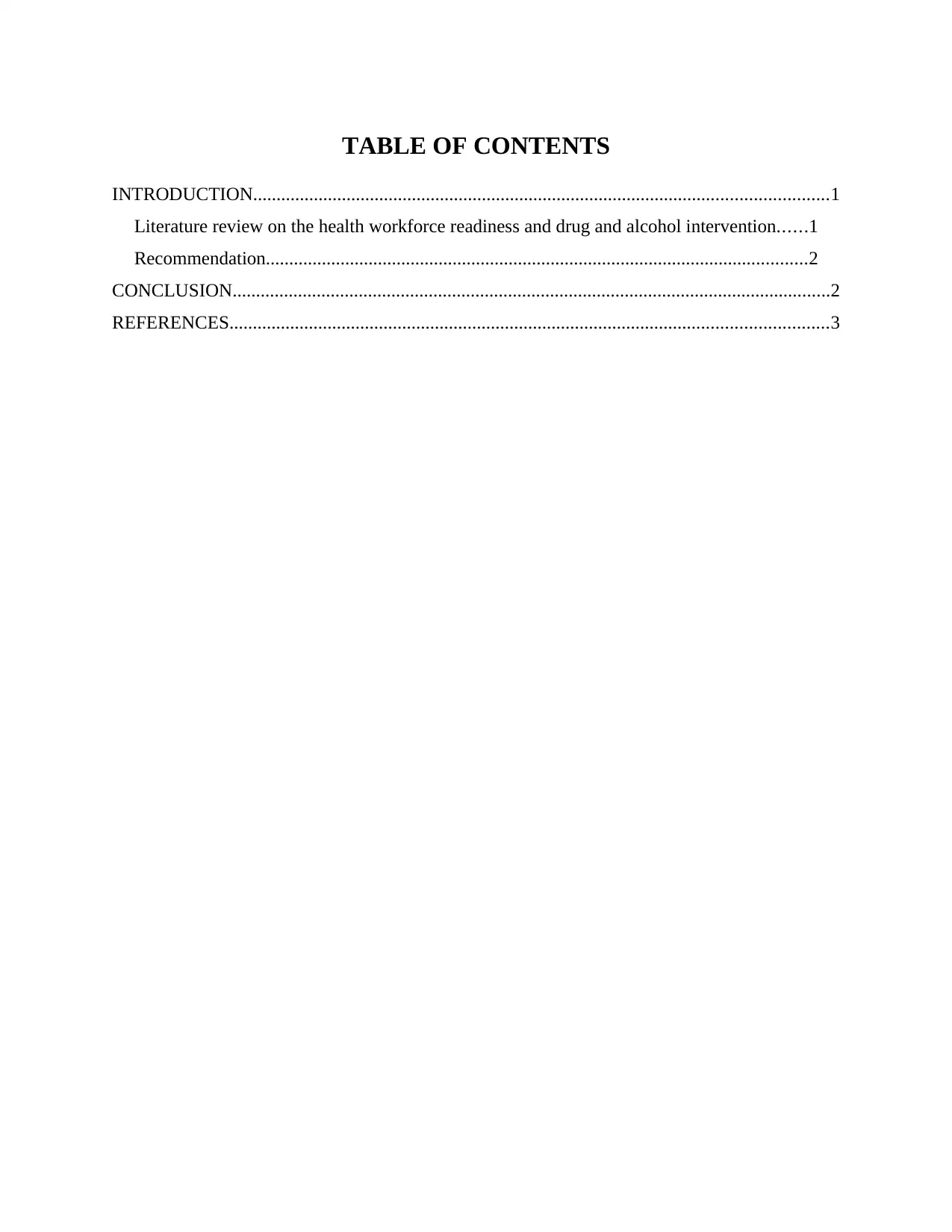
TABLE OF CONTENTS
INTRODUCTION...........................................................................................................................1
Literature review on the health workforce readiness and drug and alcohol intervention......1
Recommendation....................................................................................................................2
CONCLUSION................................................................................................................................2
REFERENCES................................................................................................................................3
INTRODUCTION...........................................................................................................................1
Literature review on the health workforce readiness and drug and alcohol intervention......1
Recommendation....................................................................................................................2
CONCLUSION................................................................................................................................2
REFERENCES................................................................................................................................3

INTRODUCTION
The alcohol and drug intervention will help the drug and alcohol addict to identify cause
of their problem (Ludtke & Gerkin, 2015). This report is based on workforce or community
challenges for implementation of alcohol intervention . It further discusses the readiness of
workforce for drug and alcohol intervention.
Literature review on the health workforce readiness and drug and alcohol intervention
As per Tanner-Smith & Lipsey (2015), it was estimated by World Health Organization
(WHO) that about 2 billion people across globe consume alcohol and are addicted to drugs.
According to Von Der Goltz & Kiefer, (2014),the use of alcohol and drugs is related with a
huge range of physical, social and mental damage. Due to this use of alcohol and drugs is ranked
as the fifth leading risk factor for premature death and disability across world. As said by
Verthein & Behrendt (2017) ,the social functioning can be negatively impacted by these
disorders. Injuries can be caused due to drinking and driving. Within age group of 18-35 years
young people are affected significantly .
As per (Intervention methods for drug & alcohol addiction, 2011). The alcohol and
drug-related problems can be prevented and reduced by the workplace program has they will
have considerable potential. To reduce employee alcohol problems many employers offer
employee assistance programs (EAPs) as well as educational programs can be used. As stated by
by Mallett & White, (2013), in order to make sure that employees maintain their careers and
productivity these programs have been made The various strategies have been made by the
workplace for implementing alcohol and drug abuse among employees.
As stated by Fiellin, Samet & O'connor, (2015), the workforce can make implenst strgei
sin order to help the perosn to get rid of the drug or alcohol addiction. A vested interest is there
of employers to keep their employees healthy and productive. They encourage the employees to
get involved in the programs. As per Frazee & Bauer, (2014), in the workplace the problem of
alcohol is identified as the linkage of drinking pattern with job performance problems. As it can
cause attendance issues, poor quality of work etc., to address alcohol problems the EAPs are the
most common intervention that is used in workplace as per Mirijello & Addolorato, (2015).
According to Dixit & Bulloch, (2016), the objective of this is to prevent loss of
employment and to make sure that people work towards their career without interruption. The
workforce can assist the the EAP coordinator in order to help the the problem of employee. The
The alcohol and drug intervention will help the drug and alcohol addict to identify cause
of their problem (Ludtke & Gerkin, 2015). This report is based on workforce or community
challenges for implementation of alcohol intervention . It further discusses the readiness of
workforce for drug and alcohol intervention.
Literature review on the health workforce readiness and drug and alcohol intervention
As per Tanner-Smith & Lipsey (2015), it was estimated by World Health Organization
(WHO) that about 2 billion people across globe consume alcohol and are addicted to drugs.
According to Von Der Goltz & Kiefer, (2014),the use of alcohol and drugs is related with a
huge range of physical, social and mental damage. Due to this use of alcohol and drugs is ranked
as the fifth leading risk factor for premature death and disability across world. As said by
Verthein & Behrendt (2017) ,the social functioning can be negatively impacted by these
disorders. Injuries can be caused due to drinking and driving. Within age group of 18-35 years
young people are affected significantly .
As per (Intervention methods for drug & alcohol addiction, 2011). The alcohol and
drug-related problems can be prevented and reduced by the workplace program has they will
have considerable potential. To reduce employee alcohol problems many employers offer
employee assistance programs (EAPs) as well as educational programs can be used. As stated by
by Mallett & White, (2013), in order to make sure that employees maintain their careers and
productivity these programs have been made The various strategies have been made by the
workplace for implementing alcohol and drug abuse among employees.
As stated by Fiellin, Samet & O'connor, (2015), the workforce can make implenst strgei
sin order to help the perosn to get rid of the drug or alcohol addiction. A vested interest is there
of employers to keep their employees healthy and productive. They encourage the employees to
get involved in the programs. As per Frazee & Bauer, (2014), in the workplace the problem of
alcohol is identified as the linkage of drinking pattern with job performance problems. As it can
cause attendance issues, poor quality of work etc., to address alcohol problems the EAPs are the
most common intervention that is used in workplace as per Mirijello & Addolorato, (2015).
According to Dixit & Bulloch, (2016), the objective of this is to prevent loss of
employment and to make sure that people work towards their career without interruption. The
workforce can assist the the EAP coordinator in order to help the the problem of employee. The
⊘ This is a preview!⊘
Do you want full access?
Subscribe today to unlock all pages.

Trusted by 1+ million students worldwide
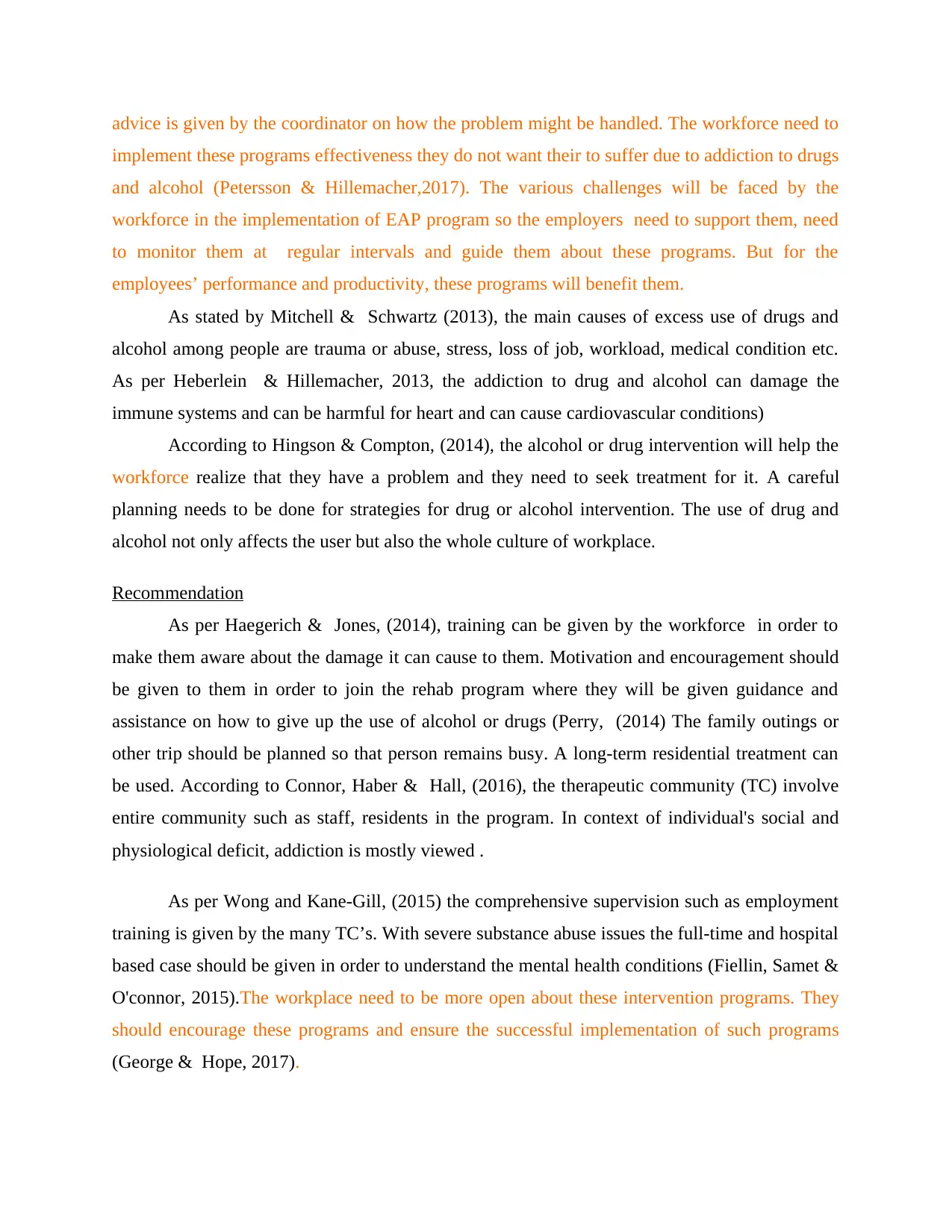
advice is given by the coordinator on how the problem might be handled. The workforce need to
implement these programs effectiveness they do not want their to suffer due to addiction to drugs
and alcohol (Petersson & Hillemacher,2017). The various challenges will be faced by the
workforce in the implementation of EAP program so the employers need to support them, need
to monitor them at regular intervals and guide them about these programs. But for the
employees’ performance and productivity, these programs will benefit them.
As stated by Mitchell & Schwartz (2013), the main causes of excess use of drugs and
alcohol among people are trauma or abuse, stress, loss of job, workload, medical condition etc.
As per Heberlein & Hillemacher, 2013, the addiction to drug and alcohol can damage the
immune systems and can be harmful for heart and can cause cardiovascular conditions)
According to Hingson & Compton, (2014), the alcohol or drug intervention will help the
workforce realize that they have a problem and they need to seek treatment for it. A careful
planning needs to be done for strategies for drug or alcohol intervention. The use of drug and
alcohol not only affects the user but also the whole culture of workplace.
Recommendation
As per Haegerich & Jones, (2014), training can be given by the workforce in order to
make them aware about the damage it can cause to them. Motivation and encouragement should
be given to them in order to join the rehab program where they will be given guidance and
assistance on how to give up the use of alcohol or drugs (Perry, (2014) The family outings or
other trip should be planned so that person remains busy. A long-term residential treatment can
be used. According to Connor, Haber & Hall, (2016), the therapeutic community (TC) involve
entire community such as staff, residents in the program. In context of individual's social and
physiological deficit, addiction is mostly viewed .
As per Wong and Kane-Gill, (2015) the comprehensive supervision such as employment
training is given by the many TC’s. With severe substance abuse issues the full-time and hospital
based case should be given in order to understand the mental health conditions (Fiellin, Samet &
O'connor, 2015).The workplace need to be more open about these intervention programs. They
should encourage these programs and ensure the successful implementation of such programs
(George & Hope, 2017).
implement these programs effectiveness they do not want their to suffer due to addiction to drugs
and alcohol (Petersson & Hillemacher,2017). The various challenges will be faced by the
workforce in the implementation of EAP program so the employers need to support them, need
to monitor them at regular intervals and guide them about these programs. But for the
employees’ performance and productivity, these programs will benefit them.
As stated by Mitchell & Schwartz (2013), the main causes of excess use of drugs and
alcohol among people are trauma or abuse, stress, loss of job, workload, medical condition etc.
As per Heberlein & Hillemacher, 2013, the addiction to drug and alcohol can damage the
immune systems and can be harmful for heart and can cause cardiovascular conditions)
According to Hingson & Compton, (2014), the alcohol or drug intervention will help the
workforce realize that they have a problem and they need to seek treatment for it. A careful
planning needs to be done for strategies for drug or alcohol intervention. The use of drug and
alcohol not only affects the user but also the whole culture of workplace.
Recommendation
As per Haegerich & Jones, (2014), training can be given by the workforce in order to
make them aware about the damage it can cause to them. Motivation and encouragement should
be given to them in order to join the rehab program where they will be given guidance and
assistance on how to give up the use of alcohol or drugs (Perry, (2014) The family outings or
other trip should be planned so that person remains busy. A long-term residential treatment can
be used. According to Connor, Haber & Hall, (2016), the therapeutic community (TC) involve
entire community such as staff, residents in the program. In context of individual's social and
physiological deficit, addiction is mostly viewed .
As per Wong and Kane-Gill, (2015) the comprehensive supervision such as employment
training is given by the many TC’s. With severe substance abuse issues the full-time and hospital
based case should be given in order to understand the mental health conditions (Fiellin, Samet &
O'connor, 2015).The workplace need to be more open about these intervention programs. They
should encourage these programs and ensure the successful implementation of such programs
(George & Hope, 2017).
Paraphrase This Document
Need a fresh take? Get an instant paraphrase of this document with our AI Paraphraser
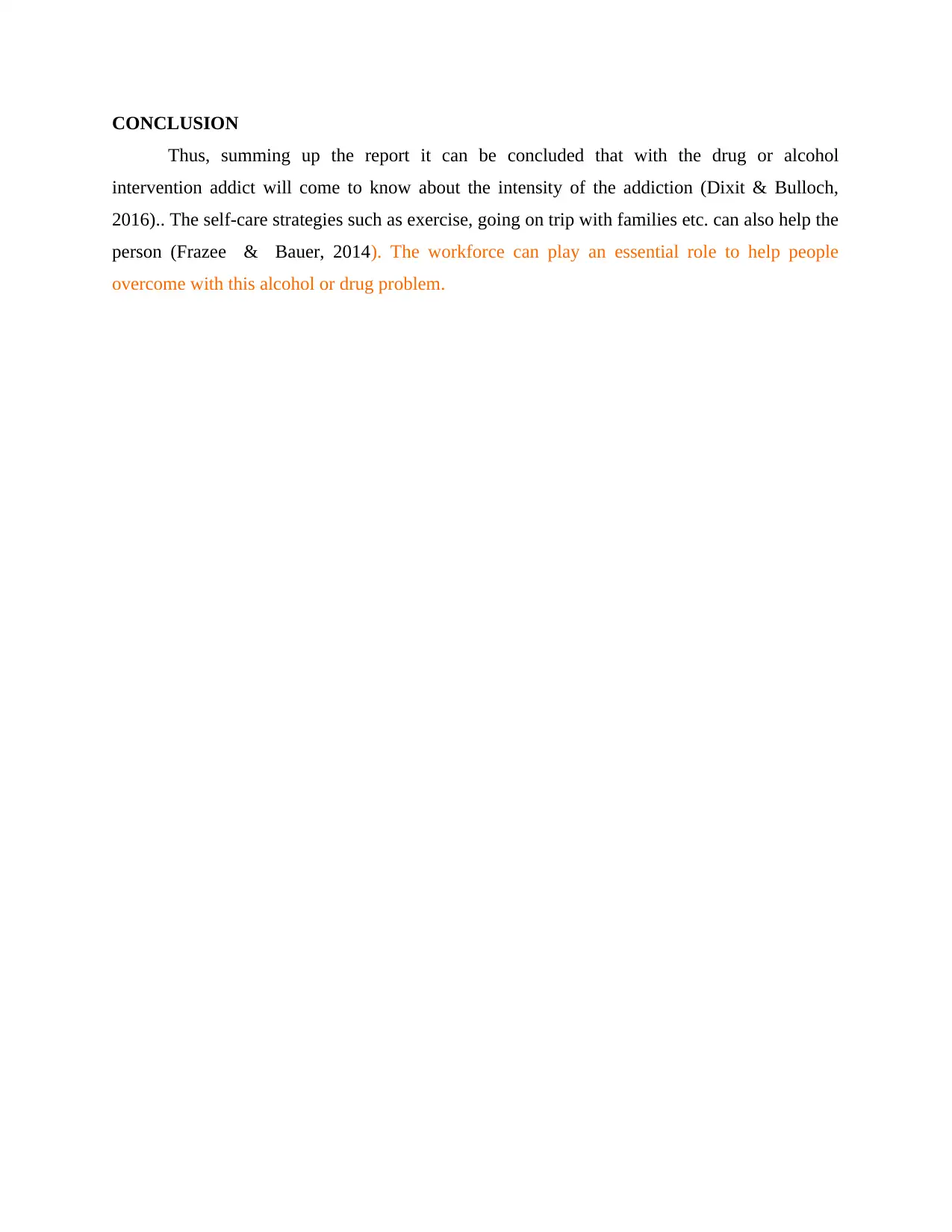
CONCLUSION
Thus, summing up the report it can be concluded that with the drug or alcohol
intervention addict will come to know about the intensity of the addiction (Dixit & Bulloch,
2016).. The self-care strategies such as exercise, going on trip with families etc. can also help the
person (Frazee & Bauer, 2014). The workforce can play an essential role to help people
overcome with this alcohol or drug problem.
Thus, summing up the report it can be concluded that with the drug or alcohol
intervention addict will come to know about the intensity of the addiction (Dixit & Bulloch,
2016).. The self-care strategies such as exercise, going on trip with families etc. can also help the
person (Frazee & Bauer, 2014). The workforce can play an essential role to help people
overcome with this alcohol or drug problem.
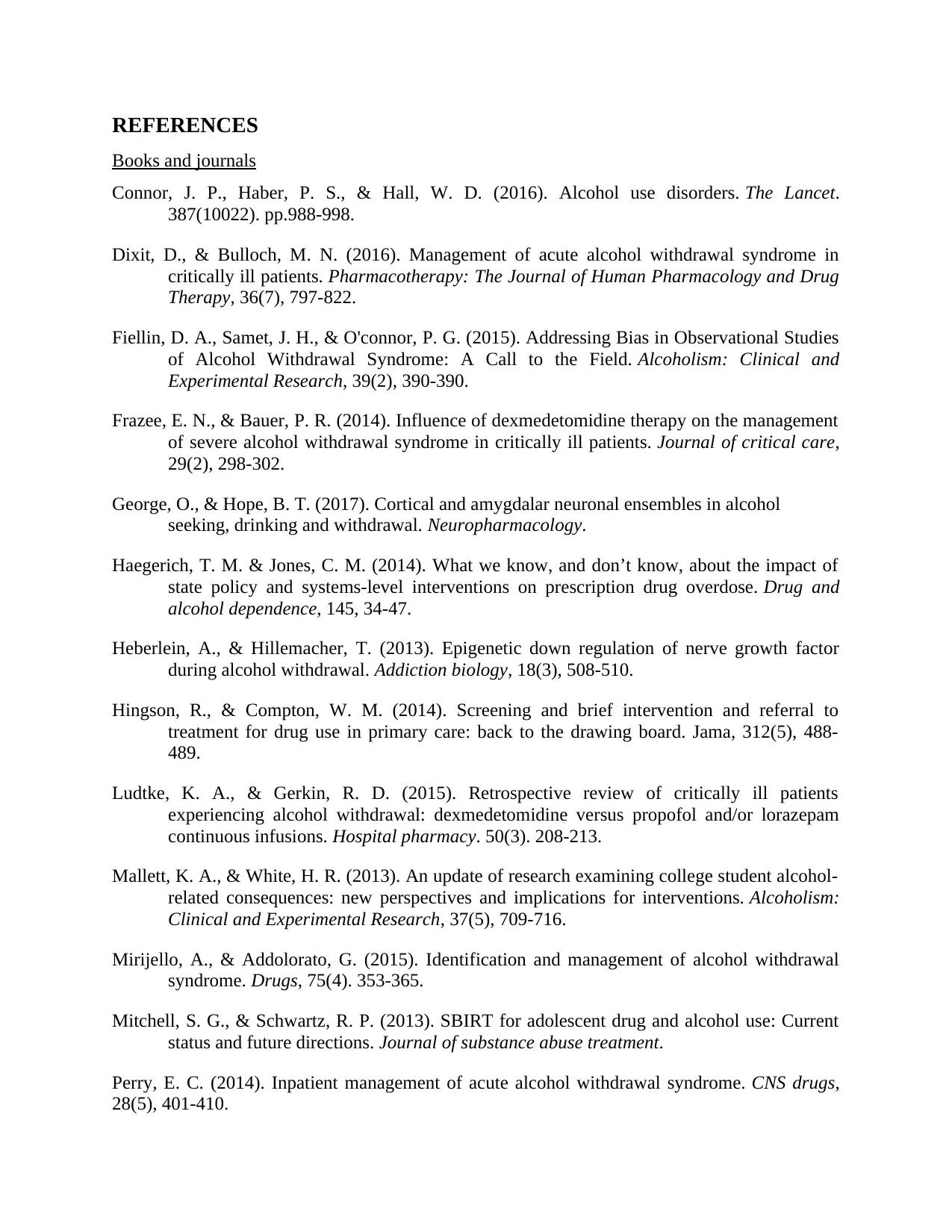
REFERENCES
Books and journals
Connor, J. P., Haber, P. S., & Hall, W. D. (2016). Alcohol use disorders. The Lancet.
387(10022). pp.988-998.
Dixit, D., & Bulloch, M. N. (2016). Management of acute alcohol withdrawal syndrome in
critically ill patients. Pharmacotherapy: The Journal of Human Pharmacology and Drug
Therapy, 36(7), 797-822.
Fiellin, D. A., Samet, J. H., & O'connor, P. G. (2015). Addressing Bias in Observational Studies
of Alcohol Withdrawal Syndrome: A Call to the Field. Alcoholism: Clinical and
Experimental Research, 39(2), 390-390.
Frazee, E. N., & Bauer, P. R. (2014). Influence of dexmedetomidine therapy on the management
of severe alcohol withdrawal syndrome in critically ill patients. Journal of critical care,
29(2), 298-302.
George, O., & Hope, B. T. (2017). Cortical and amygdalar neuronal ensembles in alcohol
seeking, drinking and withdrawal. Neuropharmacology.
Haegerich, T. M. & Jones, C. M. (2014). What we know, and don’t know, about the impact of
state policy and systems-level interventions on prescription drug overdose. Drug and
alcohol dependence, 145, 34-47.
Heberlein, A., & Hillemacher, T. (2013). Epigenetic down regulation of nerve growth factor
during alcohol withdrawal. Addiction biology, 18(3), 508-510.
Hingson, R., & Compton, W. M. (2014). Screening and brief intervention and referral to
treatment for drug use in primary care: back to the drawing board. Jama, 312(5), 488-
489.
Ludtke, K. A., & Gerkin, R. D. (2015). Retrospective review of critically ill patients
experiencing alcohol withdrawal: dexmedetomidine versus propofol and/or lorazepam
continuous infusions. Hospital pharmacy. 50(3). 208-213.
Mallett, K. A., & White, H. R. (2013). An update of research examining college student alcohol‐
related consequences: new perspectives and implications for interventions. Alcoholism:
Clinical and Experimental Research, 37(5), 709-716.
Mirijello, A., & Addolorato, G. (2015). Identification and management of alcohol withdrawal
syndrome. Drugs, 75(4). 353-365.
Mitchell, S. G., & Schwartz, R. P. (2013). SBIRT for adolescent drug and alcohol use: Current
status and future directions. Journal of substance abuse treatment.
Perry, E. C. (2014). Inpatient management of acute alcohol withdrawal syndrome. CNS drugs,
28(5), 401-410.
Books and journals
Connor, J. P., Haber, P. S., & Hall, W. D. (2016). Alcohol use disorders. The Lancet.
387(10022). pp.988-998.
Dixit, D., & Bulloch, M. N. (2016). Management of acute alcohol withdrawal syndrome in
critically ill patients. Pharmacotherapy: The Journal of Human Pharmacology and Drug
Therapy, 36(7), 797-822.
Fiellin, D. A., Samet, J. H., & O'connor, P. G. (2015). Addressing Bias in Observational Studies
of Alcohol Withdrawal Syndrome: A Call to the Field. Alcoholism: Clinical and
Experimental Research, 39(2), 390-390.
Frazee, E. N., & Bauer, P. R. (2014). Influence of dexmedetomidine therapy on the management
of severe alcohol withdrawal syndrome in critically ill patients. Journal of critical care,
29(2), 298-302.
George, O., & Hope, B. T. (2017). Cortical and amygdalar neuronal ensembles in alcohol
seeking, drinking and withdrawal. Neuropharmacology.
Haegerich, T. M. & Jones, C. M. (2014). What we know, and don’t know, about the impact of
state policy and systems-level interventions on prescription drug overdose. Drug and
alcohol dependence, 145, 34-47.
Heberlein, A., & Hillemacher, T. (2013). Epigenetic down regulation of nerve growth factor
during alcohol withdrawal. Addiction biology, 18(3), 508-510.
Hingson, R., & Compton, W. M. (2014). Screening and brief intervention and referral to
treatment for drug use in primary care: back to the drawing board. Jama, 312(5), 488-
489.
Ludtke, K. A., & Gerkin, R. D. (2015). Retrospective review of critically ill patients
experiencing alcohol withdrawal: dexmedetomidine versus propofol and/or lorazepam
continuous infusions. Hospital pharmacy. 50(3). 208-213.
Mallett, K. A., & White, H. R. (2013). An update of research examining college student alcohol‐
related consequences: new perspectives and implications for interventions. Alcoholism:
Clinical and Experimental Research, 37(5), 709-716.
Mirijello, A., & Addolorato, G. (2015). Identification and management of alcohol withdrawal
syndrome. Drugs, 75(4). 353-365.
Mitchell, S. G., & Schwartz, R. P. (2013). SBIRT for adolescent drug and alcohol use: Current
status and future directions. Journal of substance abuse treatment.
Perry, E. C. (2014). Inpatient management of acute alcohol withdrawal syndrome. CNS drugs,
28(5), 401-410.
⊘ This is a preview!⊘
Do you want full access?
Subscribe today to unlock all pages.

Trusted by 1+ million students worldwide
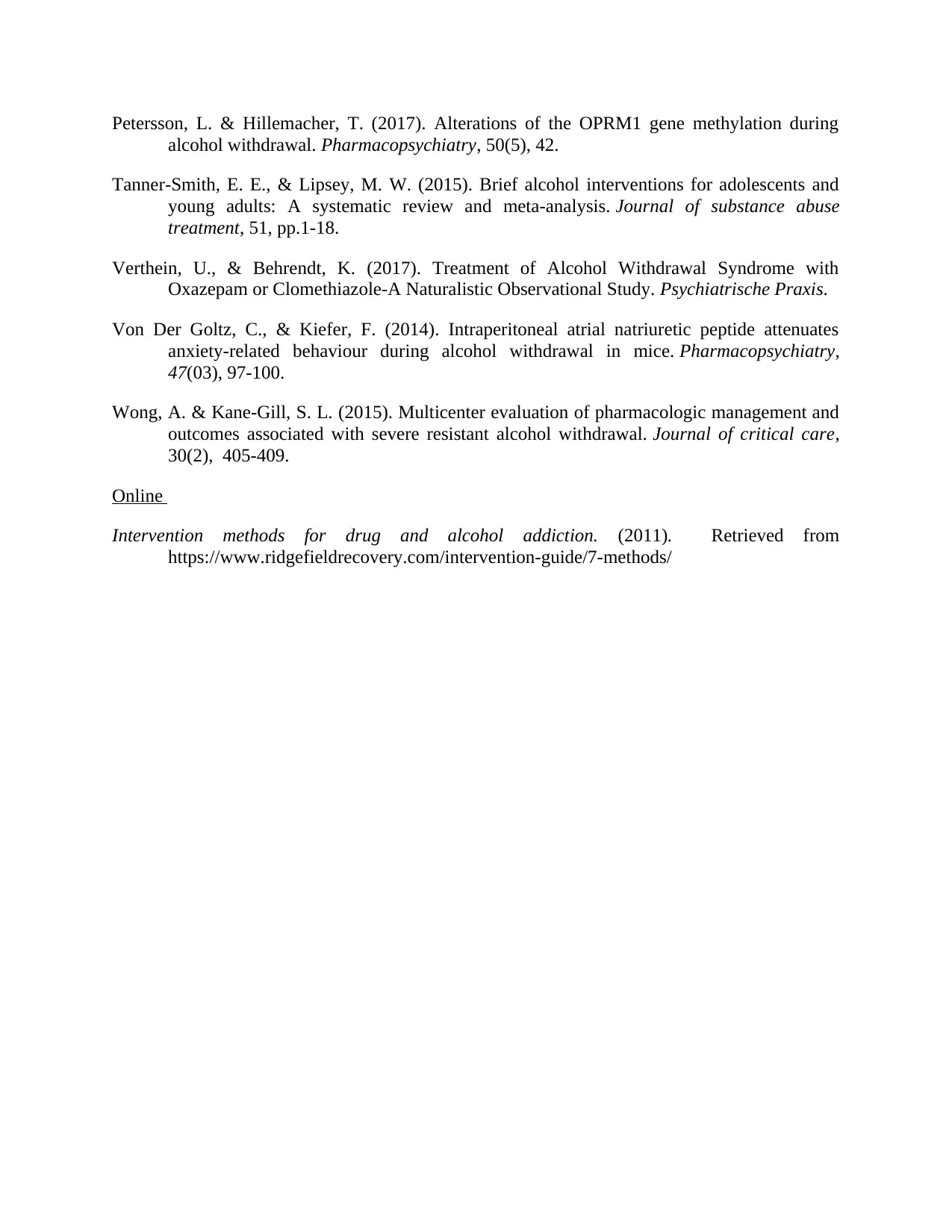
Petersson, L. & Hillemacher, T. (2017). Alterations of the OPRM1 gene methylation during
alcohol withdrawal. Pharmacopsychiatry, 50(5), 42.
Tanner-Smith, E. E., & Lipsey, M. W. (2015). Brief alcohol interventions for adolescents and
young adults: A systematic review and meta-analysis. Journal of substance abuse
treatment, 51, pp.1-18.
Verthein, U., & Behrendt, K. (2017). Treatment of Alcohol Withdrawal Syndrome with
Oxazepam or Clomethiazole-A Naturalistic Observational Study. Psychiatrische Praxis.
Von Der Goltz, C., & Kiefer, F. (2014). Intraperitoneal atrial natriuretic peptide attenuates
anxiety-related behaviour during alcohol withdrawal in mice. Pharmacopsychiatry,
47(03), 97-100.
Wong, A. & Kane-Gill, S. L. (2015). Multicenter evaluation of pharmacologic management and
outcomes associated with severe resistant alcohol withdrawal. Journal of critical care,
30(2), 405-409.
Online
Intervention methods for drug and alcohol addiction. (2011). Retrieved from
https://www.ridgefieldrecovery.com/intervention-guide/7-methods/
alcohol withdrawal. Pharmacopsychiatry, 50(5), 42.
Tanner-Smith, E. E., & Lipsey, M. W. (2015). Brief alcohol interventions for adolescents and
young adults: A systematic review and meta-analysis. Journal of substance abuse
treatment, 51, pp.1-18.
Verthein, U., & Behrendt, K. (2017). Treatment of Alcohol Withdrawal Syndrome with
Oxazepam or Clomethiazole-A Naturalistic Observational Study. Psychiatrische Praxis.
Von Der Goltz, C., & Kiefer, F. (2014). Intraperitoneal atrial natriuretic peptide attenuates
anxiety-related behaviour during alcohol withdrawal in mice. Pharmacopsychiatry,
47(03), 97-100.
Wong, A. & Kane-Gill, S. L. (2015). Multicenter evaluation of pharmacologic management and
outcomes associated with severe resistant alcohol withdrawal. Journal of critical care,
30(2), 405-409.
Online
Intervention methods for drug and alcohol addiction. (2011). Retrieved from
https://www.ridgefieldrecovery.com/intervention-guide/7-methods/
1 out of 7
Related Documents
Your All-in-One AI-Powered Toolkit for Academic Success.
+13062052269
info@desklib.com
Available 24*7 on WhatsApp / Email
![[object Object]](/_next/static/media/star-bottom.7253800d.svg)
Unlock your academic potential
Copyright © 2020–2025 A2Z Services. All Rights Reserved. Developed and managed by ZUCOL.





